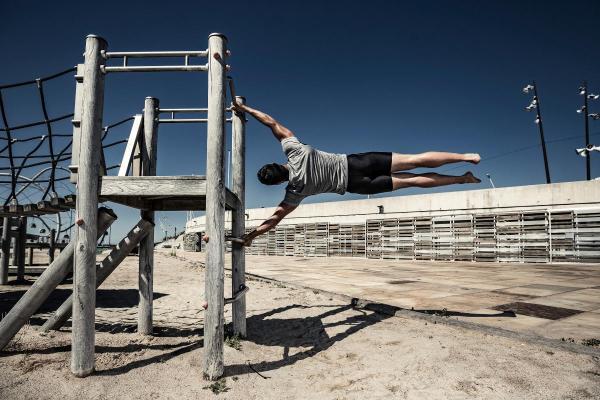Is Going to the Gym Better Than Calisthenics?


Carving out time for exercise can feel like a constant battle between work, family, and personal commitments. Many of us resort to squeezing in workouts whenever possible, often sacrificing precious hours. But what if there was a way to achieve excellent fitness without the gym commitment? Enter calisthenics, a fitness trend taking the world by storm. It utilizes your own body weight to build strength, endurance, and flexibility.
This oneHOWTO article delves into the reasons behind the surge in calisthenics' popularity, explores its numerous benefits, and investigates why it might be a better fit for your routine than a traditional gym membership.
What is calisthenics?
Calisthenics embodies a holistic approach to fitness, utilizing simple yet effective movements to build strength and improve overall health. It requires minimal to no equipment, making it a convenient and accessible workout option.
Calisthenics, a discipline utilizing one's own body weight for exercise, has surged in popularity in certain neighborhoods of U.S. cities in recent years. Originating from ancient practices in societies such as Ancient Greece and Asia, it gained traction as a fitness trend during the 18th century in France.
Today, calisthenics has evolved, thanks in part to its viral spread through social media platforms. It has become a cornerstone of functional training, with its exercises serving as foundational elements for various fitness disciplines. Among its primary objectives are enhancing physical strength, flexibility, and agility.
Notably, street workout, a branch of calisthenics, has gained significant recognition. It involves utilizing outdoor environments for exercises, blending fitness with urban environments.

Why should you start calisthenics?
As mentioned before, calisthenics has surged in popularity, with many gyms and sports institutions incorporating it into their offerings. Specialized parks dedicated to calisthenics are also increasingly common in urban areas, attracting enthusiasts of all skill levels.
The appeal of calisthenics lies in its numerous health benefits, tailored to individuals' physical condition. This form of training profoundly impacts the skeletal and muscular systems, enhancing body posture, promoting joint movement, and mitigating injury risks.
Moreover, calisthenics exercises are versatile and transferable across various sports disciplines, making them valuable for athletes of all kinds. They engage the entire body, emphasizing balance between upper and lower body strength.
Calisthenics exercises also engage multiple muscle groups at once, promoting overall strength development. As you progress, you can target specific muscle groups for more focused development. Also, calisthenics movements often involve a full range of motion, which helps improve your flexibility and joint mobility. This can lead to better posture, reduced risk of injury, and improved coordination.
Beyond physical improvements, calisthenics has positive psychological effects, reducing anxiety and stress levels. It accommodates individuals of all levels, offering exercises suitable for beginners and seasoned athletes alike. With consistent practice, noticeable improvements emerge, including reduced fat accumulation in areas like the hips and abdomen.
One of calisthenics' standout advantages is its accessibility. It can be practiced anywhere, fostering social skills and camaraderie, particularly in street workout settings. Calisthenics exercises translate well to everyday movements, improving your ability to perform daily activities with greater ease and strength. Additionally, it requires no specialized equipment or membership fees, making it inclusive and appealing to a broad audience.

Calisthenics vs. traditional gym workouts
When deciding between calisthenics and traditional gym workouts, various factors come into play, such as individual preferences, fitness objectives, and lifestyle considerations. On one hand, calisthenics exercises are characterized by their reliance on body weight and minimal equipment. This simplicity makes them accessible to people of all backgrounds and fitness levels. Whether in parks, at home, or while traveling, calisthenics can be easily incorporated into daily routines.
On the other hand, traditional gyms boast a wide array of equipment, ranging from free weights to cardio machines. However, the convenience of gym access often comes at a cost, with memberships requiring monthly fees and potential additional expenses for specialized services or classes.
In terms of financial investment, calisthenics requires minimal expenditure. With no need for pricey gym memberships, individuals can engage in calisthenics using basic equipment like pull-up bars found in public parks. In contrast, gym memberships typically involve recurring fees, which may deter some individuals seeking budget-friendly fitness options.
Moving on to exercise variety, calisthenics offers a diverse range of movements targeting various muscle groups. From push-ups and pull-ups to squats and lunges, individuals can customize their workouts based on intensity and skill level. Conversely, gyms provide access to a plethora of equipment and exercise options, catering to diverse fitness preferences. Whether engaging in resistance training or cardio workouts, gym-goers benefit from the versatility of equipment and group fitness classes.
Furthermore, calisthenics prioritizes functional movements that enhance strength, flexibility, and coordination, aligning closely with everyday activities. This focus on practicality ensures that fitness gains directly translate into improved performance in daily tasks. In contrast, traditional gym workouts often emphasize muscle isolation and hypertrophy, which may not always correlate with real-world functional fitness.
When it comes to community and support, both calisthenics and gyms offer unique advantages. Calisthenics communities foster camaraderie and mutual encouragement, with enthusiasts sharing tips and progress updates online and in person. Conversely, gyms provide opportunities for personal training and group fitness classes, fostering a supportive environment conducive to motivation and accountability.
Types of calisthenics exercises
Calisthenics exercises are highly versatile and offer numerous benefits that translate well to everyday movements, enhancing your ability to perform daily activities with greater ease and strength.
These exercises focus on compound movements that mirror natural human actions like pushing, pulling, squatting, and lunging. For instance, a push-up targets the chest, shoulders, and triceps, muscles essential for tasks such as pushing doors open or lifting groceries. Similarly, squats and lunges strengthen the lower body, aiding in activities like bending, lifting, and climbing stairs.
Calisthenics exercises can be categorized into several groups based on the movement patterns they target. Here's a breakdown of some common types:
Bodyweight presses
- Push-ups: the classic push-up works your chest, triceps, and shoulders. Variations like incline push-ups, decline push-ups, and diamond push-ups target different muscle groups within the chest and triceps.
- Dips: these exercises use parallel bars or sturdy chairs to target the chest, triceps, and shoulders.
Bodyweight squats and lunges
- Squats: squats work your quads, hamstrings, glutes, and core. Variations include jump squats, pistol squats (single-leg squats), and sumo squats.
- Lunges: these exercises target your quads, hamstrings, glutes, and core with a unilateral (single-leg) focus. Variations include walking lunges, stationary lunges, and reverse lunges.
Bodyweight rows and pull-ups
- Pull-ups: this challenging exercise uses a pull-up bar to target your back muscles, biceps, and forearms. Variations include assisted pull-ups, chin-ups (with palms facing you), and negative pull-ups.
- Rows: these exercises can be done with rings, a bar, or even a sturdy table to target your back muscles and biceps. Variations include inverted rows (done with legs elevated) and Australian rows (done with your body horizontal).
Core exercises
- Planks: planks engage your entire core, including your rectus abdominis (abs), obliques, and lower back. Variations include high planks, low planks, and side planks.
- Crunches and sit-ups: these exercises primarily target your rectus abdominis. Variations include bicycle crunches, Russian twists, and leg raises.
Advanced calisthenics
- Muscle-ups: this advanced exercise combines a pull-up with a dip, requiring significant strength and coordination.
- Pistol squats (one-legged): mastering the single-leg squat is a challenging feat that requires balance and strength.
- Handstand push-ups: these advanced push-ups require significant upper body strength and core stability to be performed with proper form.
It's important to choose exercises appropriate for your current fitness level and gradually progress to more challenging variations. Proper form is crucial to avoid injury. There are many online resources and tutorials to help you learn proper technique for each exercise.
If you want to read similar articles to Is Going to the Gym Better Than Calisthenics?, we recommend you visit our Fitness category.






